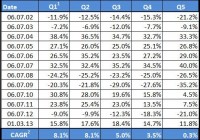ALPS Plans A Put Write ETF To Play Market Volatility
The U.S. markets have seen a volatile start to the year, thanks to the relentless slide in crude oil prices, worries about a possible exit of Greece from the Euro zone, global economic growth concerns and slumping commodity prices. Rising market volatility has led some issuers to plan for funds based on put write strategy. WisdomTree has lately filed for a fund – WisdomTree CBOE S&P 500 Put Write Strategy Fund – to generate returns by writing put options on the S&P index. Most recently, ALPS has filed for a fund based on a similar strategy. The proposed fund will go under the name of ALPS Enhanced Put Write Strategy ETF (Pending: PUTX ). Below, we have highlighted some of the key details of the recently filed fund. PUTX in Focus As per the SEC filing , the proposed actively managed product looks to maximize total return by selling put options on the SPDR S&P 500 Trust ETF (NYSEARCA: SPY ). SPY tracks the S&P 500 index measuring the performance of large-cap U.S. stocks. The premium received will then be invested in an actively managed portfolio of investment grade debt securities. The portfolio will include Treasury bills, corporate bonds, commercial paper and mortgage- and asset-backed securities, having an average duration of less than 6 months and maturity of less than one year. How might it fit in a portfolio? The fund is a good choice for investors who wish to add income and thereby boost risk-adjusted returns. Investors who believe that the U.S. equity market will trade in a narrow range next year can look to invest in the fund. A put write strategy usually outperforms the index in a down trending market and significantly outperforms the S&P 500 index in a sideways market. Moreover, put write strategies have historically outperformed buy strategies. However, investors should keep in mind that the fund’s potential return is limited to the amount of option premium it receives and that the proposed fund might underperform during strong bull markets. ETF Competition The recently filed product is quite similar in strategy to the WisdomTree CBOE S&P 500 Put Write Strategy Fund. However, unlike PUTX. which sells options on SPY ETF, WisdomTree’s product looks to sell options on the S&P 500 index itself. Moreover, while PUTX looks to invest the premium received in an actively managed portfolio of investment grade debt securities with less than one year maturity, the CBOE S&P 500 Put Write Strategy Fund will invest the premium received in one-to-three month U.S. Treasury securities. As such, both the funds might be good competitors if launched. Apart from this we also have another put-write fund in the market from ALPS itself. The fund in question – US Equity High Volatility Put Write Index ETF (NYSEARCA: HVPW ) – tracks the NYSE Arca U.S. Equity High Volatility Put Write Index. The index sells put options on the largest capitalized stocks having the highest volatility. The index uses the sales proceeds to invest in short-term U.S. Treasury securities. The fund manages an asset base of $50.8 million and trades in low volumes of roughly 23,000 shares a day. The ETF charges 95 basis points as fees and has delivered flat returns in the year-to-date frame. So, there is hardly any competition for the newly proposed fund. If launched, the fund has a fair chance of making a name for itself. However, let’s not forget that success over the longer run is ultimately a huge factor of the fund’s performance.
